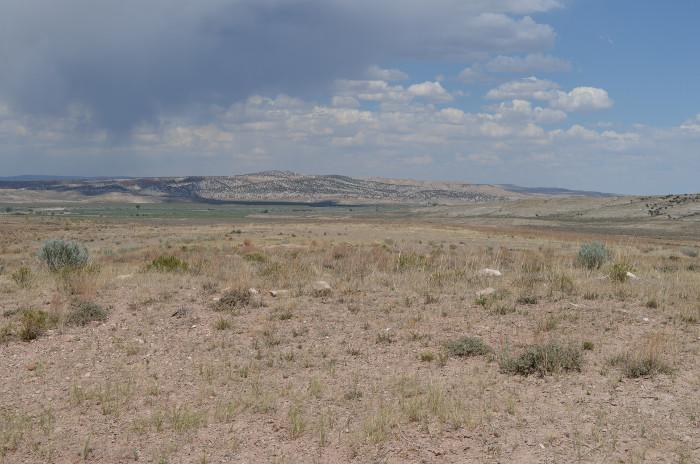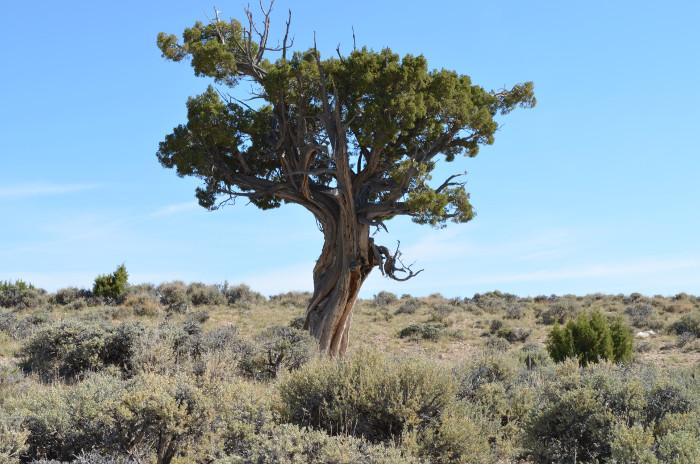The Search for two Penstemons
From the Vedauwoo we continued along I-80, passing north of the big fire raging through eastern Colorado. It would have been perfect timing to go through the Snowy, but we had timeline to keep to' and I had this obsession to see both penstemon yampaensis and p. acaulis in the wild not perfect timing for flowers, but just to know what the habitat was like.
I-80 travel along the Continental divide through the very arid high desert of Carbon Cty well named as there was an abundance of gas wells and drilling equipment. Crossing into Sweetwater Cty, we headed south on WY# 430 and crossed into northwestern Colorado heading for the Yampa R. valley and p. yampaensis. How severe the drought was I wouldn't know, but certainly this was never the land of Caanan. I had exact directions from Barrie Porteous re: one spot where the pent could be found for sure.

First we back-tracked a bit to get gas in a little town, Maybell, which lacked any sense of raison d'être but was there anyway. It's been 8 years since we crossed all the way west and the decline of rural communities continues. The gas station/country store had the usual mangle of fishing gear, ice, bacon, canned goods , beer and 2 hats one with "Where the Hell is Maybell" stitched into the crown and the other a more generic version with a trout leaping out of a river and "Colorado" emblazoned underneath that one I could live with; but, I think I paid a premium for it as the peak was frayed at the corners...well, who am I to write a paper on the state of other people's towns when I turn around and head out in the heat of the day to seek a tiny little plant that won't be in bloom indeed, where the hell is p. yampaensis?
That we found it all was solely due to Barrie's precise directions' and I stopped. It was ~ 12:30 and quite hot. The cap wasn't much use. Everything was burned to a crisp, but with not too much searching, there were forlorn little clumps of the p. yampaensis, no flowers, but obviously a survivor it would wait for a better year. The soils of the valley, silt/loam in nature, looked to be quite rich once the precious water from the Yampa R. was applied.

From there we drove along a forest service road that roughly followed the Green River, entering Utah only to see yet another fire (small), but in its final stages. This was in the area of the Flaming Gorge. Driving into Manila there is this dramatic setting of coloured stone walls of the gorge and a ribbon of blue twisting back to the north and then you enter the town of Manila, UT, (pop. ~350). In this parched country the reservoir formed behind the dam provides a well-used pond for recreational use a conflicting mix of high-powered boats and fisherman. The motel we stayed at catered to the latter functional kitchenettes with a prominent warning about tracking in mud and disposing fish guts in the sink.
A front had moved in dropping the temperatures (there was a small fire nearby too.) The wind was fresh with a complex mix of cottonwoods, juniper and I'm not sure what else a little town blessed with rare qualities. Making small talk with the couple running the motel, I spoke with enthusiasm about seeing the penstemon yampaensis that afternoon. The manager looked a bit perplexed and Irene explained it was a wildflower. "Oh," he replied, "I thought he was talking about a woman." I guess I'd better dial back the enthusiasm.
The next day we travelled west climbing out of the gorge, turning north and within 10 miles crossing into Sweetwater Cty in Wyoming, looking for penstemon acaulis. Well, you look and you can't see the forest for the trees, and then suddenly, there it is, all over the place large plants over 20cm across with the remnants of shriveled-up flowers we were a week too late for full bloom. It was very quiet and beautiful there, at about 7000', which is about the altitudinal limit and higher than I had imagined that it would grow at that elevation. With it was a gray needled phlox sp., like p. pulvinata but leaves were quite silvery and bright. There was lots of seed on the p. acaulis, not so much on the phlox (a good reminder why it's priced at $1/seed from the collectors). That morning was absolutely still - the smell of juniper and sage softened the dry edges of the land. A few locals went through in search of animals (for photos).

I always think of the seed collectors as the most dedicated folk. The difficulties of travel, the expense and utter dependence on weather make it more like a lottery than a business enterprise. But the biggest reward is, chasing spring. That's the core.



Comments (0)
Add new comment